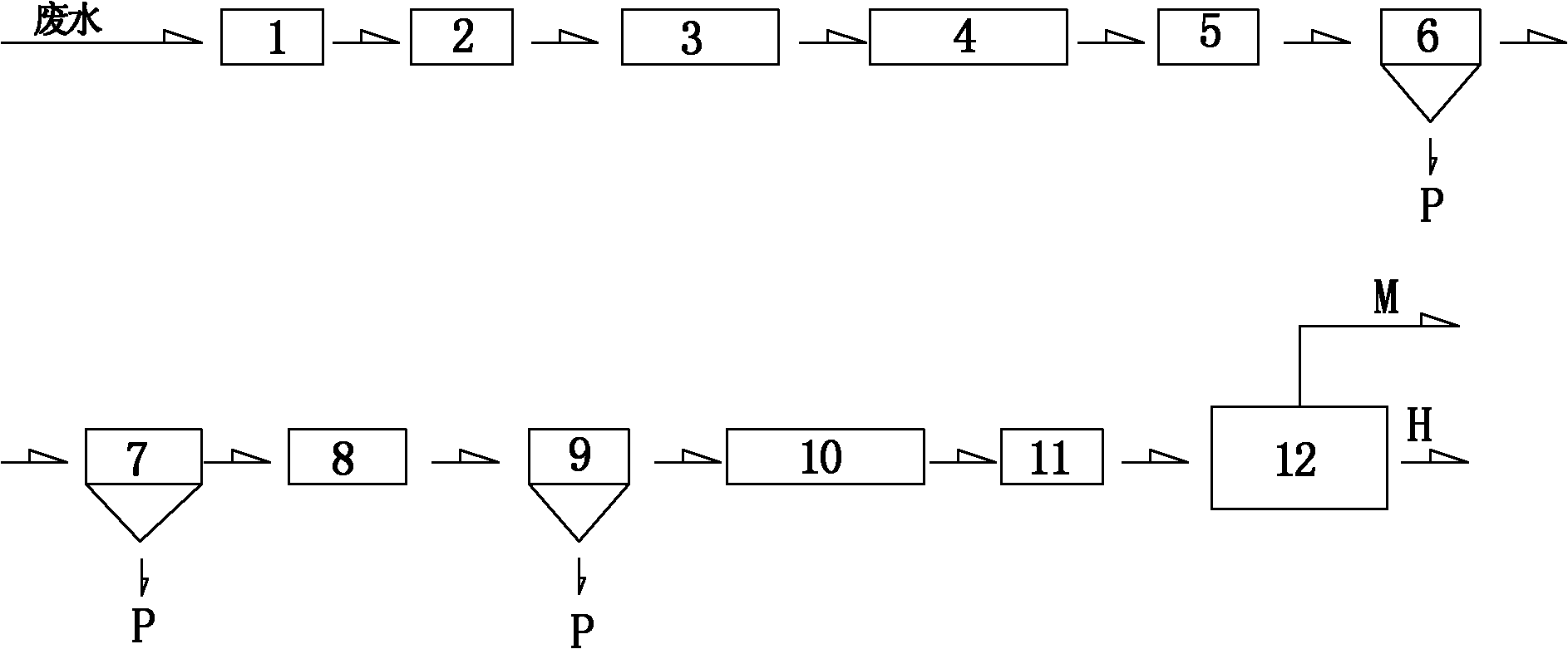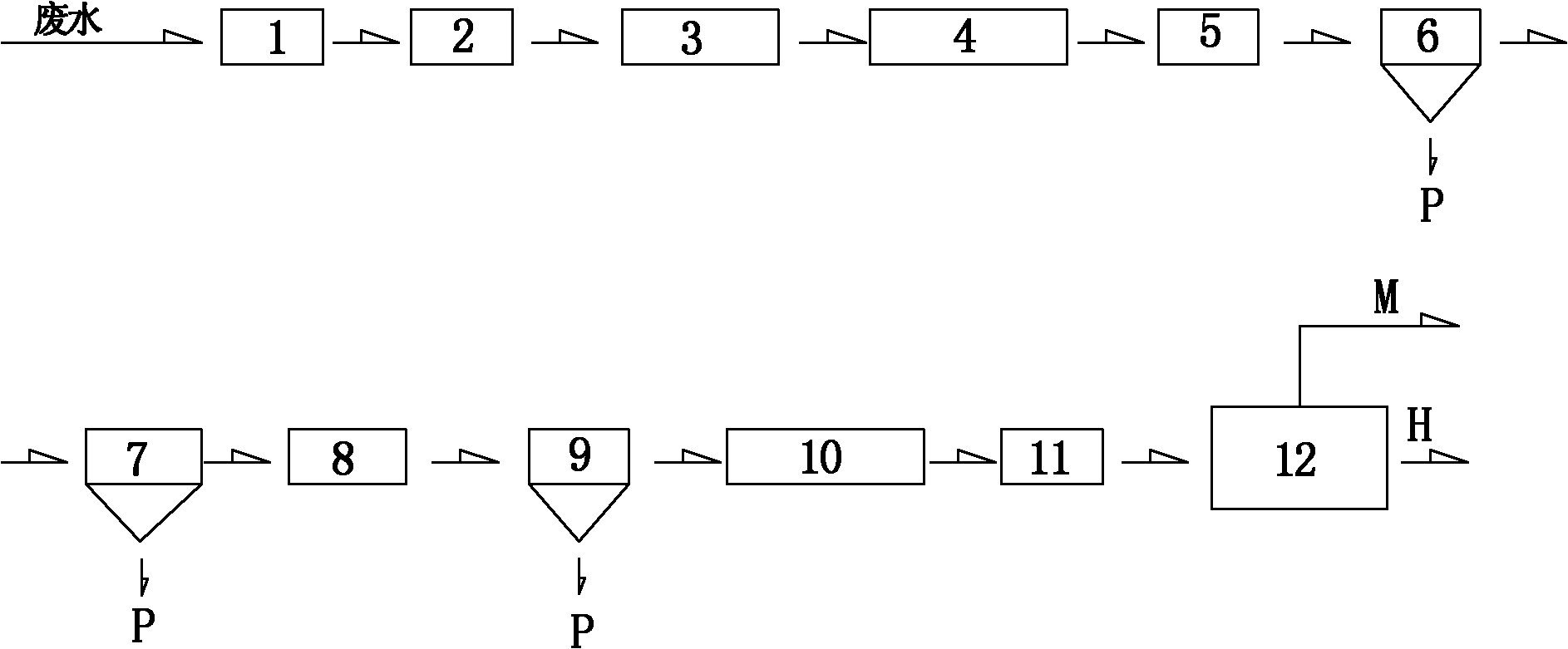Tanning wastewater recycling device and method based on electrochemistry and ultrafiltration
A technology of tanning wastewater and electrochemistry, applied in chemical instruments and methods, animal processing wastewater treatment, water/sewage multi-stage treatment, etc. And other issues
- Summary
- Abstract
- Description
- Claims
- Application Information
AI Technical Summary
Problems solved by technology
Method used
Image
Examples
Embodiment 1
[0076]Step 1 desulfurization
[0077] The tannery wastewater enters the grid filter to filter and remove large particles of solids, then flows into the adjustment tank for mixing, and then pumps the wastewater from the adjustment tank into the hydraulic sieve to filter impurities such as hair removal, and then flows into the flocculation reaction tank (desulfurization reaction tank), and the bivalence is determined online The equivalent concentration of sulfur ions, add ferrous sulfate solution according to the equivalent concentration of 1:11, react desulfurization at room temperature, divalent sulfur ions react with ferrous ions to form ferrous sulfide precipitates, and separate into iron sulfide sludge and desulfurization wastewater.
[0078] Step 2 Nanocatalytic electrolysis
[0079] The wastewater desulfurized in step 1 flows into the nano-catalyzed electrolyzer for electrolysis. The working voltage of the electrolysis is 2-500V, the voltage between the two electrodes is...
Embodiment 2
[0091] The following combination figure 1 The shown embodiment of the tannery wastewater treatment and recycling device based on catalytic electrolysis and biochemical technology gives an example of the method of tannery wastewater treatment and recycling based on catalytic electrolysis and biochemical technology.
[0092] 300 tons / day tannery wastewater treatment and purification reuse project.
[0093] The measured indicators of the tannery wastewater (comprehensive wastewater) are shown in Table 4.
[0094] Table 4
[0095] serial number
project
unit
measured value
serial number
project
unit
measured value
1
COD Cr
mg / L
3560
6
S 2-
mg / L
82
2
SS
mg / L
3110
7
Chroma
3200
3
NH 3 -N
mg / L
265
8
pH
9.3
4
Cr
mg / L
120
9
μS / cm
3200
5
BOD5
mg / L
1730
...
Embodiment 3
[0100] 3,000 tons / day tannery treatment wastewater reuse project.
[0101] The measured indicators of the tannery wastewater (comprehensive wastewater) are shown in Table 6.
[0102] Table 6
[0103] serial number
project
unit
measured value
serial number
project
unit
measured value
1
COD Cr
mg / L
3900
6
S 2-
mg / L
92
2
SS
mg / L
4070
7
Chroma
2900
3
NH 3 -N
mg / L
283
8
pH
9.3
4
Cr
mg / L
93
9
μS / cm
3766
5
BOD5
mg / L
1950
10
‰
25
[0104] Waste water through water according to 150m 3 The flow rate of / h enters the grid filter to filter and remove large particles of solids, then flows into the adjustment tank for mixing, and then the wastewater in the adjustment tank is divided into 150m 3 After the flow rate of ...
PUM
| Property | Measurement | Unit |
|---|---|---|
| Turbidity | aaaaa | aaaaa |
| Conductivity | aaaaa | aaaaa |
| Grain | aaaaa | aaaaa |
Abstract
Description
Claims
Application Information
 Login to View More
Login to View More - R&D
- Intellectual Property
- Life Sciences
- Materials
- Tech Scout
- Unparalleled Data Quality
- Higher Quality Content
- 60% Fewer Hallucinations
Browse by: Latest US Patents, China's latest patents, Technical Efficacy Thesaurus, Application Domain, Technology Topic, Popular Technical Reports.
© 2025 PatSnap. All rights reserved.Legal|Privacy policy|Modern Slavery Act Transparency Statement|Sitemap|About US| Contact US: help@patsnap.com


